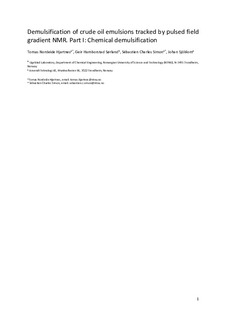| dc.contributor.author | Hjartnes, Tomas | |
| dc.contributor.author | Sørland, Geir H. | |
| dc.contributor.author | Simon, Sebastien Charles | |
| dc.contributor.author | Sjøblom, Johan | |
| dc.date.accessioned | 2019-02-11T08:47:33Z | |
| dc.date.available | 2019-02-11T08:47:33Z | |
| dc.date.created | 2019-02-08T15:42:17Z | |
| dc.date.issued | 2019 | |
| dc.identifier.issn | 0888-5885 | |
| dc.identifier.uri | http://hdl.handle.net/11250/2584693 | |
| dc.description.abstract | Emulsified water droplets must be extracted from crude oil for economical and transport purposes, which is achievable by chemical demulsification. Four different chemicals were tested on water-in-crude oil emulsions using a newly developed nuclear magnetic resonance (NMR) method. Droplet size distributions were mapped at the beginning and end of experimentation. In addition, slice selections (soft radio-frequency (RF) pulses) were used to isolate the signal from residual droplets within the separated oil phase to study coalescence patterns in the emulsion bulk. The NMR could also return rapid continuous brine profiles for analysis of sedimentation rates and free water appearance kinetics. The residual water content was isolated by strong bipolar gradient suppression, thereby allowing focus on the smaller droplets still emulsified in the top region in the brine profiles. Optimum concentrations were found for each chemical, and blends of several chemical demulsifiers were noticeably more efficient than the single-component demulsifiers in this study. | nb_NO |
| dc.language.iso | eng | nb_NO |
| dc.publisher | American Chemical Society | nb_NO |
| dc.relation.uri | https://pubs.acs.org/doi/10.1021/acs.iecr.8b05165 | |
| dc.title | Demulsification of Crude Oil Emulsions Tracked by Pulsed Field Gradient (PFG) Nuclear Magnetic Resonance (NMR). Part I: Chemical Demulsification | nb_NO |
| dc.type | Journal article | nb_NO |
| dc.type | Peer reviewed | nb_NO |
| dc.description.version | acceptedVersion | nb_NO |
| dc.source.journal | Industrial & Engineering Chemistry Research | nb_NO |
| dc.identifier.doi | 10.1021/acs.iecr.8b05165 | |
| dc.identifier.cristin | 1675028 | |
| dc.relation.project | Norges forskningsråd: 255174 | nb_NO |
| dc.description.localcode | © American Chemical Society 2019. This is the authors accepted and refereed manuscript to the article. Locked until 16.01.2020 due to copyright restrictions. | nb_NO |
| cristin.unitcode | 194,66,30,0 | |
| cristin.unitname | Institutt for kjemisk prosessteknologi | |
| cristin.ispublished | true | |
| cristin.fulltext | original | |
| cristin.fulltext | postprint | |
| cristin.fulltext | preprint | |
| cristin.qualitycode | 2 | |
